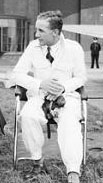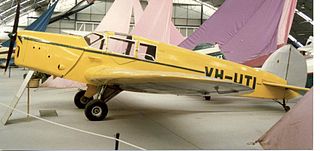Related Research Articles

Royal Air Force Hooton Park or more simply RAF Hooton Park, on the Wirral Peninsula, Cheshire, is a former Royal Air Force station originally built for the Royal Flying Corps in 1917 as a training aerodrome for pilots in the First World War. During the early/mid-1930s, it was one of the two airfields handling scheduled services for the Merseyside region. Hooton Park was home to No. 610 Squadron and, post Second World War, to No. 611 and No. 663 (AOP) Squadron.
Pobjoy Airmotors and Aircraft was a British manufacturer of small aircraft engines. The company was purchased by Short Brothers shortly before the start of World War II, production continuing until the end of the war.

Alexander Adolphus Dumphries Henshaw, was a British air racer in the 1930s and a test pilot for Vickers Armstrong during the Second World War.

Leslie Everett Baynes, AFRAeS was an English aeronautical engineer.

Heston Aerodrome was an airfield located to the west of London, England, operational between 1929 and 1947. It was situated on the border of the Heston and Cranford areas of Hounslow, Middlesex. In September 1938, the British Prime Minister, Neville Chamberlain, flew from Heston to Germany three times in two weeks for talks with Adolf Hitler, and returned to Heston from the Munich Conference with the paper referred to in his later "Peace for our time" speech from 10 Downing Street.

Mildred Mary Petre was a British record-breaking racing motorist, speedboat racer and aviator in the 1920s and 1930s, and later, successful businesswoman. Commonly referred to as Mrs Victor Bruce, she was also known in contemporary references as Mary Petre Bruce, Mildred Bruce, Mildred Mary Bruce and Mary Victor Bruce.

The Comper C.L.A.7 Swift is a British 1930s single-seat sporting aircraft produced by Comper Aircraft Company Ltd of Hooton Park, Cheshire.

The British Aircraft Manufacturing Company Limited was a 1930s British aircraft manufacturer based at London Air Park, Hanworth, Middlesex, England.

The Comper Mouse was a 1930s British three-seat cabin monoplane designed by Nicholas Comper, and built by the Comper Aircraft Company at Heston Aerodrome in 1933.
Nicholas Comper was an English aviator and aircraft designer, whose most notable success was the 1930s Comper Swift monoplane racer.
Heston Aircraft Company was a British aircraft manufacturer based at Heston Aerodrome, Middlesex, England.

The Heston T.1/37 was a 1930s British single-engined monoplane military trainer aircraft with two open cockpits, designed and developed by Heston Aircraft Company Ltd. It was not accepted for service.
United Airways Ltd was a British airline operating in 1935, ending as part of British Airways Ltd.

The Comper Streak was a single-engined, single-seat racing monoplane built in the UK in the mid-1930s. It was not successful as a racer and only one was produced.
The Comper Kite was a single-engined, two-seat touring monoplane built in the UK, derived from the contemporary Comper Streak racer. Only one was built.
Comper may refer to:

London Air Park, also known as Hanworth Air Park, was a grass airfield in the grounds of Hanworth Park House, operational 1917–1919 and 1929–1947. It was on the southeastern edge of Feltham, now part of the London Borough of Hounslow. In the 1930s, it was best known as a centre for private flying, society events, visits by the Graf Zeppelin airship, and for aircraft manufacture by the Whitehead Aircraft Company during World War I and General Aircraft Limited (GAL) 1934–1949; in total over 1,650 aircraft were built here.

Stephen Villiers Appleby was an English pilot and a leading proponent of the Mignet Pou-du-Ciel "Flying Flea" aircraft.
The Cierva C.25 was a British 1930s single-seat autogiro produced by Comper Aircraft Company Ltd of Hooton Park, Cheshire.
Midland & Scottish Air Ferries was Scotland's first airline, operating from 1933 to 1934. It is particularly noted for pioneering flights to the Inner Hebrides
References
- Boughton, Terence. 1963. The Story of The British Light Aeroplane. John Murray
- Jackson, A.J. (1974). British Civil Aircraft since 1919 Vol.2. London: Putnam. ISBN 0-370-10010-7.
- Meaden, Jack & Fillmore, Malcolm. (Winter 2003). The Comper Lightplanes. Air-Britain Archive (quarterly). Air-Britain. ISSN 0262-4923
- Riding, Richard T. August&September 1978. British Pre-war Ultra-lights No.28: Comper Swift. Aeroplane Monthly. IPC Media
- Riding, Richard T. 1987. Ultralights: The Early British Classics. Patrick Stephens ISBN 0-85059-748-X
- Riding, Richard T. March 2003. Database: Comper Swift. Aeroplane Monthly. IPC Media